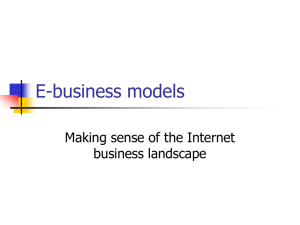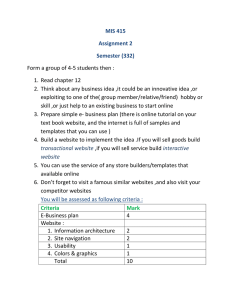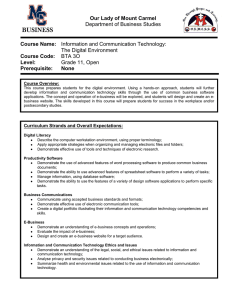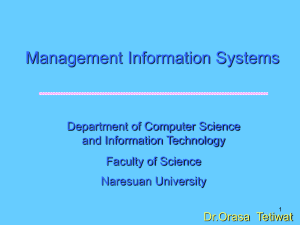An ex t e n s ive survey of
advertisement
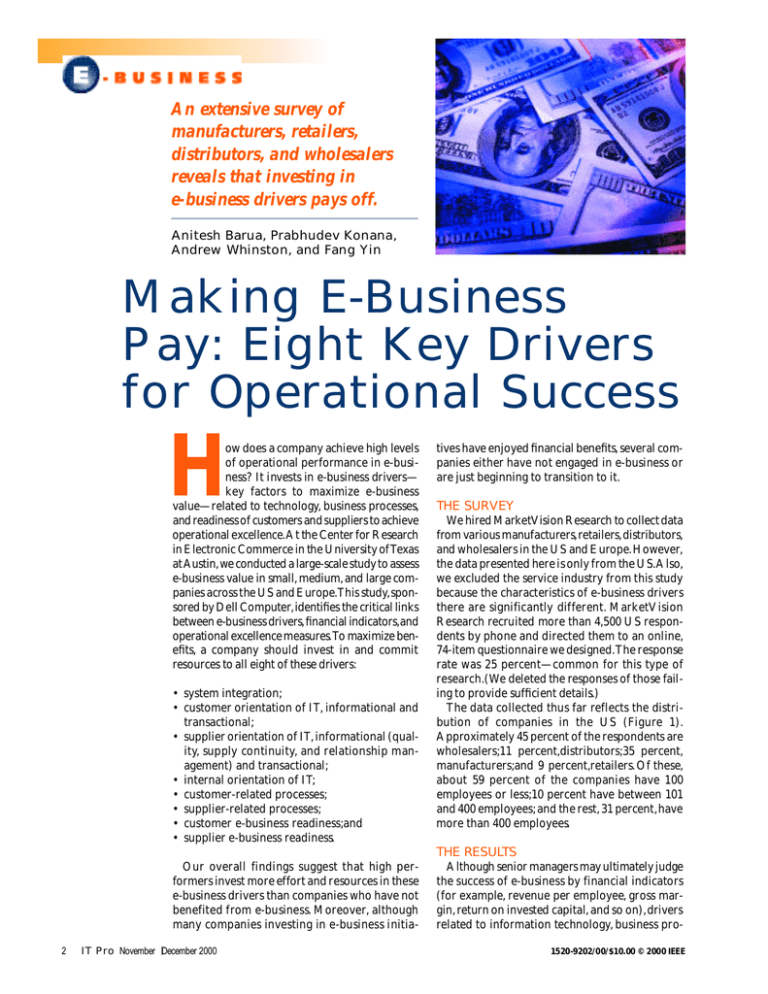
An extensive survey of manufacturers, retailers, distributors, and wholesalers reveals that investing in e-business drivers pays off. Anitesh Barua, Prabhudev Konana, Andrew Whinston, and Fang Yin Making E-Business Pay: Eight Key Drivers for Operational Success H ow does a company achieve high levels of operational performance in e-business? It invests in e-business drivers— key factors to maximize e-business value—related to technology, business processes, and readiness of customers and suppliers to achieve operational excellence.At the Center for Research in Electronic Commerce in the University of Texas at Austin, we conducted a large-scale study to assess e-business value in small, medium, and large companies across the US and Europe.This study,sponsored by Dell Computer,identifies the critical links between e-business drivers, financial indicators,and operational excellence measures.To maximize benefits, a company should invest in and commit resources to all eight of these drivers: • system integration; • customer orientation of IT, informational and transactional; • supplier orientation of IT, informational (quality, supply continuity, and relationship management) and transactional; • internal orientation of IT; • customer-related processes; • supplier-related processes; • customer e-business readiness;and • supplier e-business readiness. tives have enjoyed financial benefits, several companies either have not engaged in e-business or are just beginning to transition to it. THE SURVEY We hired MarketVision Research to collect data from various manufacturers,retailers, distributors, and wholesalers in the US and Europe.However, the data presented here is only from the US.Also, we excluded the service industry from this study because the characteristics of e-business drivers there are significantly different. MarketVision Research recruited more than 4,500 US respondents by phone and directed them to an online, 74-item questionnaire we designed.The response rate was 25 percent—common for this type of research.(We deleted the responses of those failing to provide sufficient details.) The data collected thus far reflects the distribution of companies in the US (Figure 1). Approximately 45 percent of the respondents are wholesalers;11 percent,distributors;35 percent, manufacturers;and 9 percent,retailers. Of these, about 59 percent of the companies have 100 employees or less;10 percent have between 101 and 400 employees; and the rest, 31 percent,have more than 400 employees. THE RESULTS Our overall findings suggest that high performers invest more effort and resources in these e-business drivers than companies who have not benefited from e-business. Moreover, although many companies investing in e-business initia2 IT Pro November ❘ December 2000 Although senior managers may ultimately judge the success of e-business by financial indicators (for example, revenue per employee, gross margin, return on invested capital, and so on),drivers related to information technology, business pro1520-9202/00/$10.00 © 2000 IEEE cesses, and the company’s external environment are key ingredients. IT-related drivers include the level of integration between online and back-office applications, and informational and transactional capabilities of online systems. Business-process drivers include standards and procedures for interactions with customers and trading partners. And an external environment conducive to e-business success depends on the readiness of customers and suppliers. By choosing the levels of appropriate e-business drivers, companies can achieve operational excellence in day-today operations. Operational excellence measures include the extent of business conducted online, the extent of MRO (maintenance, repairs, and operation) and production goods procured online, the percentage of customer service requests resolved online, and order delivery cycle time. Figure 1. Survey demographics in the US: (a) employee distribution; (b) industry respondents. 1 System integration The integration level of different information systems includes such areas as Web applications and back-office systems in the organization.Table 1 summarizes the survey results for this driver. Table 1. System integration. Respondents agreeing, somewhat to strongly (percentage) in companies with Statement about system integration no increase in revenue an increase in revenue per employee per employee Overall Various internal groups can easily share data. 60 66 64 Downstream processes and systems automatically reflect order changes. 50 51 50 Systems can easily transmit, integrate, and process data from suppliers, vendors, and customers. 46 61 54 Systems allow continuous monitoring of order status at various stages in the process 56 63 60 Employees can easily retrieve information from various databases for decision support. 60 68 65 November ❘ December 2000 IT Pro 3 E-BUSINESS 2 Customer orientation of IT Are companies exploiting the Internet and other technologies for their customer and supplier relationships? We found that companies have made significantly more progress orienting their IT applications to customers than to suppliers, but both areas need improvement. Customer orientation measures the extent to which online applications are oriented toward • providing information to customers, and • allowing transactional features for customers to place and manage orders online. Informational customer orientation measures the extent to which online applications provide customers with product information,customer service, ordering services, and customization. Transactional customer orientation concerns whether companies provide a secure Web site where customers can submit or modify orders, learn about order status, and make payments. Informational customer orientation. Companies can exploit the Internet to enhance customer experiences. Although many companies have sufficiently invested in providing various levels of online customer services, they still can’t personalize content and orders. Overall, companies that have observed increases in financial measures such as revenue per employee have higher customer orientation levels than companies with no observed increase in financial performance. Table 2 makes this clear. Many companies (69 percent) provide productrelated information (for example, catalog, product description,specifications, and price) online, whereas only 49 percent provide some online capabilities to customize orders. However, just 33 percent of companies that have not observed any increase in revenue per employee allow online customization of orders, compared with 64 percent of companies that have observed financial gains.Furthermore, approximately 66 percent of companies cannot personalize content (for example, order history and order status) when customers log onto company Web sites. Even worse,about 73 percent of the companies with no observed revenue per employee do not personalize content. Approximately 72 percent of companies do not exploit the benefits of online forums and virtual communities to enhance stickiness—a characteristic that encourages visitors to stay at or return to a Web site—and information exchange. Surprisingly, about 48 percent Table 2. Customer orientation of IT applications (informational). Respondents agreeing, somewhat to strongly (percentage) in companies with Statement about informational capabilities 4 no increase in revenue an increase in revenue per employee per employee Overall All product-related information (price, product description, and catalog) is available online. 56 81 69 Customers can customize their orders online without phone or face-to-face interactions. 33 64 49 A comprehensive FAQ section is available online. 45 58 52 Customers can conveniently contact service representatives or seek service online. 61 83 74 Customers can interact using online forums or communities (such as chat rooms or bulletin boards). 23 33 28 Customers see personalized content (products, prices, order history, and order status) when logging onto a Web site. 27 40 34 IT Pro November ❘ December 2000 Table 3. Customer orientation of IT applications (transactional). Respondents agreeing, somewhat to strongly (percentage) in companies with Statement about transactional capabilities no increase in revenue an increase in revenue per employee per employee Overall Can customers submit orders online? 54 82 69 Can customers modify orders online? 30 57 45 Can customers pay online? 36 68 55 Are customers automatically notified of their order status? 30 53 42 Can customers access a secure Web site for ordering and other interactions? 46 74 63 of companies do not provide customers with contact information or a FAQ section related to products and services. Transactional customer orientation. Table 3 summarizes the survey responses regarding transactional features for customer orientation. Most companies (69 percent) let customers submit orders online, but only 45 percent let customers modify the orders after submission. The differences are particularly striking between companies that observed financial benefits and those that did not. For instance, only 30 percent of the companies that observed no increase in revenue per employee allow modification of an order, as compared with 57 percent of the companies that observed substantial benefits. Furthermore, about 58 percent of companies have no capabilities to notify customers of their order status. This percentage increases to 70 percent for companies with no increase in revenue per employee.This result might be due to a lack of systems integration within the companies. November ❘ December 2000 IT Pro 5 E-BUSINESS 3 Supplier orientation of IT To what extent do companies exchange information with suppliers and make transactional features available to them? Informational supplier orientation issues include the following: • Quality. Are online applications oriented toward suppliers and vendors to share quality information (for instance, field-incidence reports), provide feedback,and process order changes via the Web? • Supply continuity. Do suppliers receive online information about company resources, such as inventory, product schedules, and product road maps? • Relationship management. Do companies provide online information to manage and maintain supplier and vendor relationships (for example, contact lists, FAQs, and discussion forums)? Transactional supplier orientation of IT concerns whether the company and suppliers can transmit and process electronic invoices, verify order status interactively, and make payments electronically. Informational supplier orientation. Companies can exploit the Web to build supplier relationships, manage quality, and let information be an economic substitute for inventory and lead time through electronic coordination and collaboration with their suppliers. However, as Table 4 shows, only 27 percent of companies communicate customer feedback and field-incidence reports to their suppliers in real time. Likewise, only 26 percent share process quality information electronically with their trading partners,and this finding is consistent with the lack of established supplier-oriented processes needed for e-business. Thirty percent of companies have online capabilities to share inventory information with trading partners. Only about 14 percent have processes for sharing pro- Table 4. Supplier orientation of IT applications: quality, supply continuity, and relationship management. Respondents agreeing, somewhat to strongly (percentage) Statement about quality Share customer feedback and field-incident reports with suppliers and vendors in real time. 27 Share process quality information electronically with relevant trading partners in real time. 26 Communicate changes electronically to trading partners in real time. 24 Statement about supply continuity Share continually updated inventory information with trading partners online. 30 Share continually updated production schedules and capacity (machines, manpower) information with trading partners online. 14 Share continually updated product demand information (actual and forecasted) online. 26 Statement about relationship management 6 Online communities (discussion forums, online chat, and so on) are available to suppliers. 16 A comprehensive online FAQ section (for example, contact information, glossary, events) is available to trading partners. 32 Frequently updated supplier evaluation reports are available online. 11 IT Pro November ❘ December 2000 Table 5. Supplier orientation of IT applications: transactional features. Questions about transactional features Respondents agreeing, somewhat to strongly (percentage) Do systems allow automated invoice transmission and processing? 34 Do systems track the status of orders online? 28 Are payments electronically sent to suppliers? 28 duction-related information—such as schedules, manpower availability, and machine downtime—with suppliers. Surprisingly, only 26 percent of companies strongly or somewhat agree to provide expected demand information to suppliers online.As with customer orientation, less than 16 percent of companies have online communities for suppliers to share information online, and about 11 percent provide supplier and vendor evaluation reports online. Companies with increased revenue per employee generally invested more in orienting their applications to suppliers. Transactional supplier orientation. Only 34 percent of companies have electronic invoice transmission and processing capabilities, suggesting that most communication with suppliers still relies on phone, fax, or face-to-face exchanges. Less than 28 percent of companies can track order status online with suppliers.Surprisingly, only about 28 percent of companies electronically pay suppliers and vendors, despite the progress made in electronic money transfer. Generally, most companies have not made significant progress in improving supply-chain efficiencies. Table 5 summarizes the survey results for this driver. 4 Internal orientation How well does the company orient IT applications toward internal constituents to provide online services such as administrative processes, dissemination of best practices, and financial information? How well does the company exploit the Internet and other IT applications for internal operations? Despite access to the Internet and other technologies, many companies (49 percent) still do not use intranets for information dissemination and access. Approximately 39 percent of companies manage all their administrative processes online. Likewise, only 31 percent disseminate best practices and project information through intranets.This result implies that companies are not leveraging technology for knowledge management and other initiatives for organizational learning. Table 6 summarizes the responses. Table 6. Internal orientation of IT applications. Questions about internal orientation Respondents agreeing, somewhat to strongly (percentage) Can employees retrieve required information through the company intranet? 51 Can employees manage administrative processes online? 39 Are best practices and project management information available online through the company intranet? 31 November ❘ December 2000 IT Pro 7 E-BUSINESS 5 Customer-related processes Are customer processes designed for e-business practices? Results indicate that they are. As Table 7 shows, approximately 71 percent of companies have procedures to quickly incorporate customer feedback into organizational processes. More than 75 percent have a single point of contact to handle Respondents agreeing, somewhat to strongly (percentage) in companies with Table 7. Alignment of customer processes for e-business. Customer process measure customer service requests, and 81 percent have very few steps to resolve such requests.These results are consistent with those regarding IT customer orientation, in which 74 percent of the companies now allow customers to seek customer service online (see Table 1). no increase in revenue an increase in revenue per employee per employee Overall Customers generally have one contact point for all service needs. 68 80 75 There are a few steps to resolve customer complaints. 75 86 81 Customer feedback is quickly disseminated into organizational processes. 59 80 71 6 Supplier-related processes Are supplier processes aligned with e-business? Table 8 shows that, unlike customer-related processes, supplier processes for e-business lag behind. Surprisingly, about 72 percent of companies have no established processes to share e-business-critical information (such as demand forecasts and product road maps) with their Table 8. Alignment of supplier processes for e-business. Supplier process measure 8 suppliers or vendors. About 57 percent lack standard operating procedures to cover all procurement scenarios that will likely hinder e-business adoption.Also, only about 41 percent have processes to monitor supplier or vendor quality, which implies that companies do not fully exploit IT for improving quality. Respondents agreeing, somewhat to strongly (percentage) in companies with no increase in revenue an increase in revenue per employee per employee Overall Method of sharing product road map and demand forecast with suppliers is well defined. 26 28 27 Information-exchange policies with suppliers (frequency, precision, real-time or delayed, format, and channel) are well defined. 29 38 33 The standard operating procedures cover all procurement scenarios (for example, well-defined rules for large versus small procurement). 41 45 43 Supplier selection criteria are well documented. 43 52 48 Supplier evaluation metrics are well defined. 31 34 31 Supplier quality monitoring process is well defined. 37 45 41 IT Pro November ❘ December 2000 7 & 8 Customer and supplier e-business readiness How do companies perceive customer and supplier readiness for e-business? Even though most companies do not fully exploit IT for procurement, internal processes, or customer service, a majority appear to have a positive attitude toward their customers and suppliers with respect to e-business. Companies, however, treat their customers as if they are more ready for e-business and e-commerce than their suppliers. Also, a significant gap exists between the attitudes toward and perception of e-business and the actual adoption by both customers and suppliers. Table 9. Perceived e-business readiness of customers and suppliers. A majority of the respondents (67 to 69 percent) believe their customers are comfortable with e-commerce security and privacy, and feel it is important to engage in e-commerce. However, only about 49 percent of suppliers and vendors appear comfortable with e-business security and privacy, and only 53 percent consider engaging in e-business important. About 56 percent of the respondents feel ready to engage in e-business using Internet-based systems. Table 9 summarizes the e-business readiness responses. Respondents agreeing, somewhat to strongly (percentage) in companies with no increase in revenue an increase in revenue per employee per employee Overall Customer process measure Customers feel comfortable about security and privacy in e-commerce. 52 78 69 Customers consider engaging in e-commerce important. 49 76 67 Suppliers have Internet-based systems to engage in e-commerce. 47 59 56 Suppliers feel comfortable about security and privacy in e-business. 41 55 49 Suppliers are willing to share information electronically with a company. 53 65 62 Suppliers consider engaging in e-business. 47 56 53 Suppliers consider improving coordination and collaboration important. 65 66 65 Supplier readiness statement A lthough several companies have made significant progress in developing online customer relationships, there is untapped potential to improve supplier relationships and the entire value chain. Approximately 70 to 89 percent of the companies surveyed do not have any form of online transactional or informational sharing capabilities with their suppliers. Lack of supplier readiness is also a key barrier to e-business adoption.Successful e-business practice requires readiness on the part of all players in the value chain, and companies that have adopted e-business must invest in increasing their trad- ing partners’ readiness. Customer e-business readiness is critical as well. Companies must invest in educating and training customers to adopt e-business practices. Moreover, many companies haven’t fully exploited the power of customized products and services delivered via the Web. For instance, only about 34 percent of companies personalize content when customers log onto their Web site. Companies also need to better exploit the Web and related technologies for internal process efficiency in such areas as administration, human resources, and internal knowledge sharing. November ❘ December 2000 IT Pro 9 E-BUSINESS Finally, company processes have not been aligned for ebusiness practices such as information sharing, quality monitoring, and supplier selection and evaluation. Technologies and processes are synergistic, and investing in one without the other is unlikely to provide significant payoff. A majority of companies (67 to 73 percent) still do not have formal processes to share a product road map or to exchange information with suppliers. ■ Anitesh Barua is an associate professor of information sys tems and associate director of the Center for Research in Electronic Commerce at the McCombs School of Business, University of Texas at Austin.Contact him at barua@mail. utexas.edu. 10 IT Pro November ❘ December 2000 Prabhudev Konana is an assistant professor of management information systems and the assistant director of the Center for Research in Electronic Commerce at the McCombs School of Business, University of Texas at Austin.Contact him at pkonana@mail.utexas.edu. Andrew Whinston is a professor of information systems, economics, and computer science; the Hugh Roy Cullen Centennial Chair in business administration; and the direc tor of the Center for Research in Electronic Commerce at the McCombs School of Business, University of Texas at Austin.Contact him at abw@uts.cc.utexas.edu. Fang Yin is a doctoral student in management information systems at the McCombs School of Business, University of Texas at Austin.Contact him at fyin@mail.utexas.edu.
